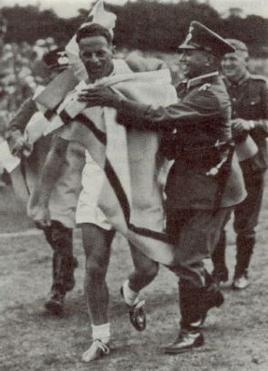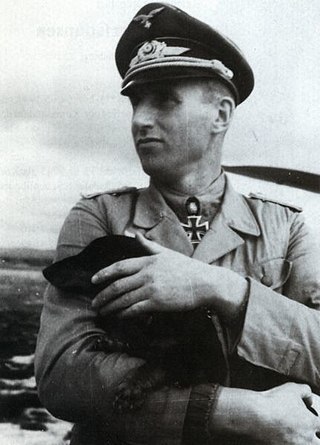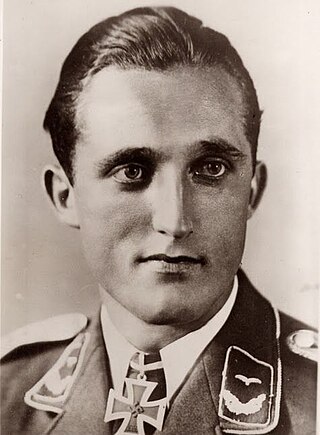Related Research Articles

The VIII Fighter Command was a United States Army Air Forces unit of command above the wings and below the numbered air force. Its primary mission was command of fighter operations within the Eighth Air Force. In the World War II European Theater, its primary mission was air superiority. Its last assignment was with the United States Air Forces in Europe at RAF Honington,

Anton "Toni" Hackl was a German Luftwaffe military aviator during World War II, a fighter ace credited with 192 enemy aircraft shot down in over 1,000 combat missions. The majority of his victories were claimed over the Eastern Front, with 87 claims over the Western Front. Of his 87 victories over the Western Allies, at least 32 were four-engined bombers, a further 24 victories were unconfirmed.

Gotthard Handrick was a German Olympic athlete and German fighter pilot during the Spanish Civil War and World War II.
Max Ibel is credited as one of the creators of the Luftwaffe. He was also a recipient of the Knight's Cross of the Iron Cross.
Jagdfliegerführer Ostmark was formed September 6, 1943 in Vienna, subordinated to 7. Jagd-Division. The headquarters was located at Wien-Kobenzl. The unit was redesignated 8. Jagd-Division on June 15, 1944.
Jagdgeschwader 300 was a Luftwaffe fighter-wing of World War II. JG 300 was formed on June 26, 1943 in Deelen as Stab/Versuchskommando Herrmann, from July 18, 1943 as Stab/JG Herrmann and finally renamed on August 20, 1943 to Stab/JG 300. Its first Geschwaderkommodore was Oberstleutnant Hajo Herrmann.
Jagdgeschwader z. b. V. was a Luftwaffe fighter wing of World War II. The abbreviation z. b. V. is German and stands for zur besonderen Verwendung.

Erwin Clausen was a German Luftwaffe military aviator during World War II, a fighter ace credited with 132 aerial victories—that is, 132 aerial combat encounters resulting in the destruction of the enemy aircraft—claimed in 561 combat missions. He was "ace-in-a-day" four times, shooting down five or more aircraft on a single day.
2nd Fighter Division was one of the primary divisions of the German Luftwaffe in World War II. It was formed 1 May 1942 in Stade The Division was disbanded on 8 May 1945. The Division was subordinated to XII. Fliegerkorps, I. Jagdkorps and IX (J) Fliegerkorps.
1st Fighter Division was one of the primary divisions of the German Luftwaffe in World War II. It was formed on 1 May 1942 in Deelen from Stab/1. Nachtjagd-Division and redesignated 3. Jagd-Division on 15 September 1943. It was immediately reformed on 15 September 1943 in Döberitz from the 4. Jagd-Division. The Division was subordinated to XII. Fliegerkorps, I. Jagdkorps and IX (J) Fliegerkorps.

Friedrich Geißhardt was a German former Luftwaffe fighter ace and recipient of the Knight's Cross of the Iron Cross with Oak Leaves during World War II. A flying ace or fighter ace is a military aviator credited with shooting down five or more enemy aircraft during aerial combat. The Knight's Cross of the Iron Cross was the highest award in the armed forces of Germany during World War II.
Franz Barten was a World War II fighter ace from Germany. He was born on 26 January 1912 at Saarbrücken. Barten was credited with having shot down a total of 52 Allied aircraft.

Karl Gratz was an Austrian-born Luftwaffe fighter pilot during World War II. As a fighter ace, he was credited with 138 aerial victories claimed in more than 900 missions. Gratz claimed the majority of his victories over the Eastern Front, and 17 over the Western Front.
3rd Fighter Division was one of the primary divisions of the German Luftwaffe in World War II. It was formed 1 May 1942 in Metz. The Division was redesignated 4. Jagd-Division on 15 September 1943 and reformed 15 September 1943 in Deelen from 1. Jagd Division.
4th Fighter Division was one of the primary divisions of the German Luftwaffe in World War II. It was formed in August 1942 in Döberitz from the sub units of the 2nd Air Corps. The Division was redesignated 1st Fighter Division on 15 September 1943 and reformed 15 September 1943 in Metz from 3rd Fighter Division of the 2nd Fighter Corps. The unit was disbanded on 8 September 1944.
5th Fighter Division was one of the primary divisions of the German Luftwaffe in World War II. It was formed in June 1943 and subordinated to the 12th Air Corps. The Division was reorganised as 7th Fighter Division on 15 September 1943 and reformed again the same day in Paris and subordinated to the 2nd Fighter Corps. The unit was relocated to Karlsruhe-Durlach in October 1944 and subordinated to Luftwaffenkommando West. The division was redesignated to 16th Air Division on 26 January 1945.
Alfred Teumer was a German Luftwaffe military aviator and fighter ace during World War II. He is credited with 76 aerial victories claimed in over 300 combat missions. This figure includes 66 aerial victories on the Eastern Front, and further ten claims over the Western Allies.
30th Fighter Division was one of the primary divisions of the German Luftwaffe in World War II. It was formed in September 1943 in Berlin and disbanded on 16 March 1944. The Division was subordinated to the Luftwaffenbefehlshaber Mitte and the I. Jagdkorps.

Willy Unger was a German Luftwaffe military aviator during World War II. As a fighter ace, he is credited with 24 enemy aircraft shot down in 59 combat missions. This figure includes 21 heavy bombers claimed on the Western Front in defense of the Reich missions and three on the Eastern Front.

Nachtjagdgruppe 10 was a German Luftwaffe night fighter gruppe (group) during World War II. It was formed on 1 January 1944 at Werneuchen with 3 Staffel (squadrons). It was subordinated to the 1. Jagd-Division, stationed at Döberitz. On 6 March 1945, NJGr 10 transferred to Liebenwalde and disbanded in April 1945. The remnants of NJGr 10 were absorbed by Nachtjagdgeschwader 5. Its main task was to explore new and revised tactical deployment of night fighters, test the latest search and detection equipment in conjunction with the test site for radar equipment under combat conditions, and place the anti-Mosquito effort under a more centralised command.